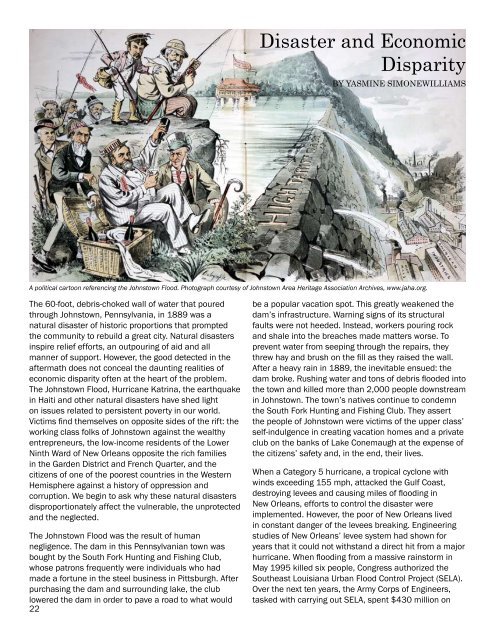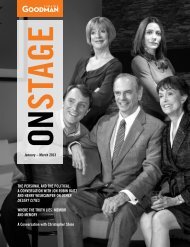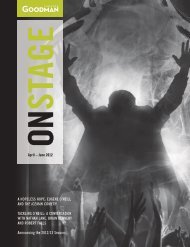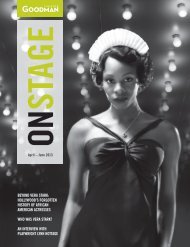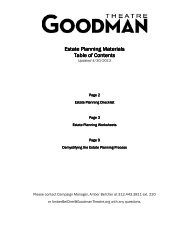A True History of the Johnstown Flood Study - Goodman Theatre
A True History of the Johnstown Flood Study - Goodman Theatre
A True History of the Johnstown Flood Study - Goodman Theatre
You also want an ePaper? Increase the reach of your titles
YUMPU automatically turns print PDFs into web optimized ePapers that Google loves.
Disaster and Economic<br />
Disparity<br />
BY YASMINE SIMONEWILLIAMS<br />
A political cartoon referencing <strong>the</strong> <strong>Johnstown</strong> <strong>Flood</strong>. Photograph courtesy <strong>of</strong> <strong>Johnstown</strong> Area Heritage Association Archives, www.jaha.org.<br />
The 60-foot, debris-choked wall <strong>of</strong> water that poured<br />
through <strong>Johnstown</strong>, Pennsylvania, in 1889 was a<br />
natural disaster <strong>of</strong> historic proportions that prompted<br />
<strong>the</strong> community to rebuild a great city. Natural disasters<br />
inspire relief efforts, an outpouring <strong>of</strong> aid and all<br />
manner <strong>of</strong> support. However, <strong>the</strong> good detected in <strong>the</strong><br />
aftermath does not conceal <strong>the</strong> daunting realities <strong>of</strong><br />
economic disparity <strong>of</strong>ten at <strong>the</strong> heart <strong>of</strong> <strong>the</strong> problem.<br />
The <strong>Johnstown</strong> <strong>Flood</strong>, Hurricane Katrina, <strong>the</strong> earthquake<br />
in Haiti and o<strong>the</strong>r natural disasters have shed light<br />
on issues related to persistent poverty in our world.<br />
Victims find <strong>the</strong>mselves on opposite sides <strong>of</strong> <strong>the</strong> rift: <strong>the</strong><br />
working class folks <strong>of</strong> <strong>Johnstown</strong> against <strong>the</strong> wealthy<br />
entrepreneurs, <strong>the</strong> low-income residents <strong>of</strong> <strong>the</strong> Lower<br />
Ninth Ward <strong>of</strong> New Orleans opposite <strong>the</strong> rich families<br />
in <strong>the</strong> Garden District and French Quarter, and <strong>the</strong><br />
citizens <strong>of</strong> one <strong>of</strong> <strong>the</strong> poorest countries in <strong>the</strong> Western<br />
Hemisphere against a history <strong>of</strong> oppression and<br />
corruption. We begin to ask why <strong>the</strong>se natural disasters<br />
disproportionately affect <strong>the</strong> vulnerable, <strong>the</strong> unprotected<br />
and <strong>the</strong> neglected.<br />
The <strong>Johnstown</strong> <strong>Flood</strong> was <strong>the</strong> result <strong>of</strong> human<br />
negligence. The dam in this Pennsylvanian town was<br />
bought by <strong>the</strong> South Fork Hunting and Fishing Club,<br />
whose patrons frequently were individuals who had<br />
made a fortune in <strong>the</strong> steel business in Pittsburgh. After<br />
purchasing <strong>the</strong> dam and surrounding lake, <strong>the</strong> club<br />
lowered <strong>the</strong> dam in order to pave a road to what would<br />
22<br />
be a popular vacation spot. This greatly weakened <strong>the</strong><br />
dam’s infrastructure. Warning signs <strong>of</strong> its structural<br />
faults were not heeded. Instead, workers pouring rock<br />
and shale into <strong>the</strong> breaches made matters worse. To<br />
prevent water from seeping through <strong>the</strong> repairs, <strong>the</strong>y<br />
threw hay and brush on <strong>the</strong> fill as <strong>the</strong>y raised <strong>the</strong> wall.<br />
After a heavy rain in 1889, <strong>the</strong> inevitable ensued: <strong>the</strong><br />
dam broke. Rushing water and tons <strong>of</strong> debris flooded into<br />
<strong>the</strong> town and killed more than 2,000 people downstream<br />
in <strong>Johnstown</strong>. The town’s natives continue to condemn<br />
<strong>the</strong> South Fork Hunting and Fishing Club. They assert<br />
<strong>the</strong> people <strong>of</strong> <strong>Johnstown</strong> were victims <strong>of</strong> <strong>the</strong> upper class’<br />
self-indulgence in creating vacation homes and a private<br />
club on <strong>the</strong> banks <strong>of</strong> Lake Conemaugh at <strong>the</strong> expense <strong>of</strong><br />
<strong>the</strong> citizens’ safety and, in <strong>the</strong> end, <strong>the</strong>ir lives.<br />
When a Category 5 hurricane, a tropical cyclone with<br />
winds exceeding 155 mph, attacked <strong>the</strong> Gulf Coast,<br />
destroying levees and causing miles <strong>of</strong> flooding in<br />
New Orleans, efforts to control <strong>the</strong> disaster were<br />
implemented. However, <strong>the</strong> poor <strong>of</strong> New Orleans lived<br />
in constant danger <strong>of</strong> <strong>the</strong> levees breaking. Engineering<br />
studies <strong>of</strong> New Orleans’ levee system had shown for<br />
years that it could not withstand a direct hit from a major<br />
hurricane. When flooding from a massive rainstorm in<br />
May 1995 killed six people, Congress authorized <strong>the</strong><br />
Sou<strong>the</strong>ast Louisiana Urban <strong>Flood</strong> Control Project (SELA).<br />
Over <strong>the</strong> next ten years, <strong>the</strong> Army Corps <strong>of</strong> Engineers,<br />
tasked with carrying out SELA, spent $430 million on


